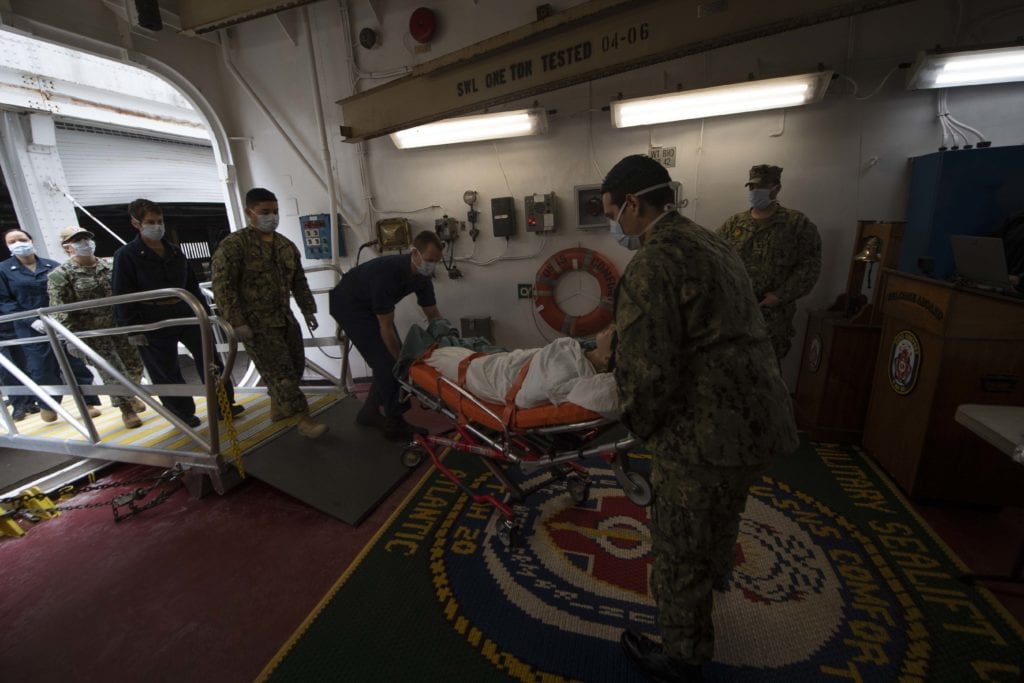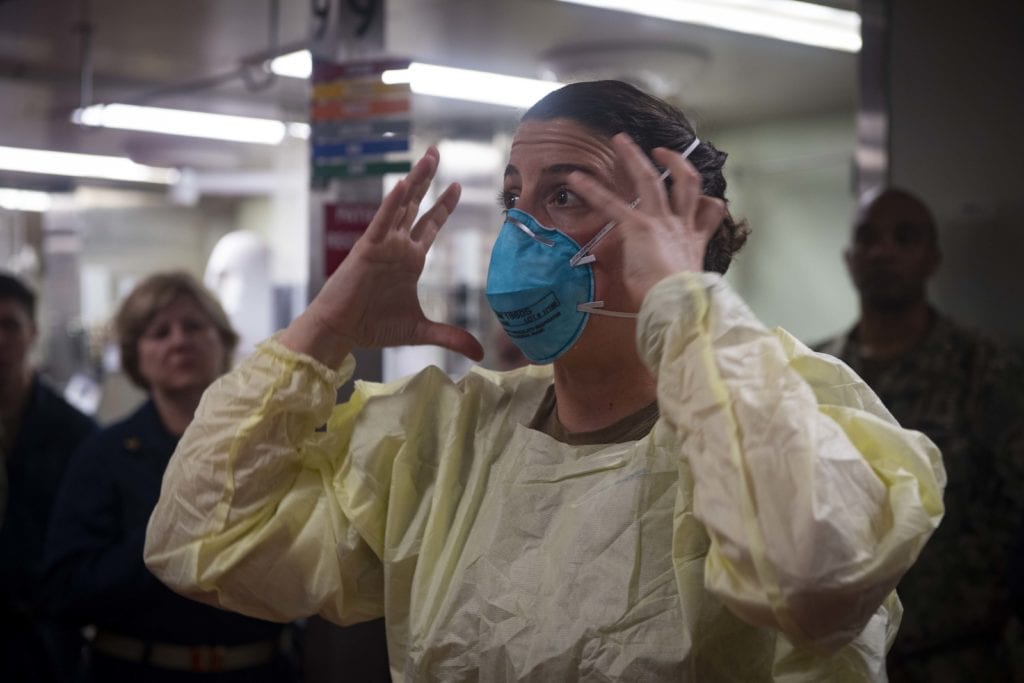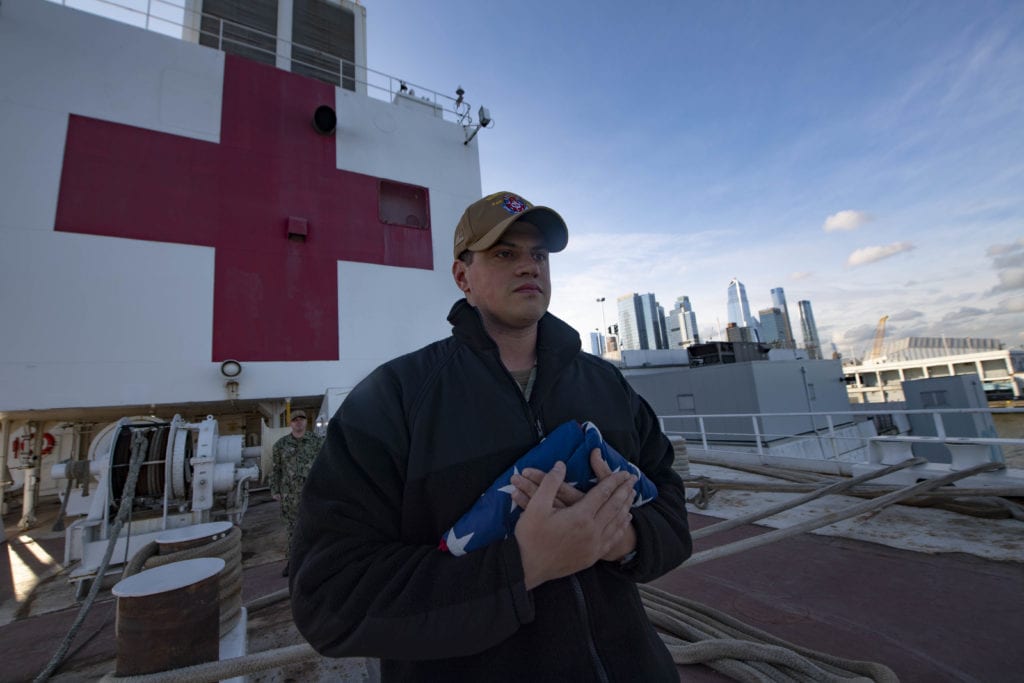
ARLINGTON, Va. — Both commanders of medical operations on the two Military Sealift Command hospital ships sent to ease the load of non-coronavirus cases at hard-pressed local hospitals in Los Angeles and New York City said their staffs have treated only a handful of patients so far.
Capt. John Rotruck, commander of the Medical Treatment Facility USNS Mercy in Los Angeles, and Capt. Patrick Amersbach, the Medical Treatment Facility USNS Comfort commander in New York, told an April 2 Pentagon press conference by phone that their vessels were rushed to both cities to be in place before hospitals were overwhelmed by COVID-19 patients so, as Rotruck said, “when capacity demand really increases, we’ll be ready.”
See: Navy dismisses outspoken captain of the USS Theodore Roosevelt
The Mercy, based in San Diego, reached L.A. on March 27 and received its first patient March 29. Since then, 15 patients have been transferred from local hospitals to the hospital ship. Five have been discharged and 10 others are still being treated on board.
That effective throughput showed the hospital ships could act as “a relief valve for local hospitals,” Rotruck said. Otherwise, if the ships filled up “we would be of little use to the local hospitals.” The Norfolk, Virginia-based Comfort set sail six days ahead of original plan on March 28 and reached New York two days later. Comfort staff have treated 30 people since April 1.

“We were brought into New York City as quickly as possible,” Amersbach said, to “accept COVID-19-free patients to take pressure off local health systems before the wave hit.”
Both huge vessels can provide a full spectrum of services, including general surgeries, critical care and ward care for adults. That will allow local health care professionals to focus on treating COVID-19 patients and for shore-based hospitals to use their intensive care units and ventilators for threating those patients. Neither ship is accepting obstetrics or pediatric patients, which the captains said would require more specialists and equipment than the ships have for their primary mission.

Rotruck said the cases doctors on the Mercy have treated ranged from traumatic accident injuries to gastrointestinal, heart and lung issues. In both cities, all patients are referred by local hospitals to a central command center for disposition and are screened and tested for COVID-19 before they can come aboard the ships.
Medical staff on the ships, who include Navy reservists as well as active-duty personnel, were screened for COVID-19 before they came on board and any new staff will have to self-isolate in New York or Los Angeles for 14 days before boarding either ship.
If higher authorities changed the ships’ mission to treat COVID-19 patients, Rotruck speculated that Mercy would have to “transfer all the non-COVID-19 patients off the ship and become a 100% COVID operation.” Amersbach said if the mission changed, all the Comfort’s beds would have to be reconfigured to keep those with the virus far apart from those not infected.
Rotruck said the apparent deliberate derailment of a railroad locomotive near the port area where the Mercy is berthed did not affect the ship’s staff, patients or services. “It happened well outside of our fence line,” said Rotruck, adding that the Navy and Defense Department will adjust force protection procedures if there are additional security concerns.
In New York City, were supplies of personal protection equipment (PPE) for local medical staff are running critically low, Amersbach said the Comfort hasn’t received any requests for supplies or equipment from hospitals, adding that such requests would be forwarded to the Federal Emergency Management Agency. “We currently have enough PPE, equipment and stores on board,” he said, “at least for the next couple of weeks, depending on how many patients we get aboard the ship.”
The two hospital ships aren’t the only Navy Department responses to the medical needs of the civilian population, acting Navy Secretary Thomas Modly told a press briefing on April 1.
Scalable, modular, rapidly erectable shelters, known as Expeditionary Medical Facilities, were sent to temporary medical stations at convention centers in Dallas and New Orleans. Marine Corps Systems Command and the Naval Information Warfare Center, Pacific, were designing 3-D parts to assist the University of California-San Diego convert ventilators to handle multiple patients, Modly said.
- Shall We Play a Game? Winning Isn’t the Point, Experts Say - April 5, 2023
- U.S. Goal: Maintaining Extended Presence in Arctic’s Harsh Environment - April 4, 2023
- Joint, Combined Exercise Shows Marine Littoral Regiment Idea is on ”Right Track’ - February 24, 2023






